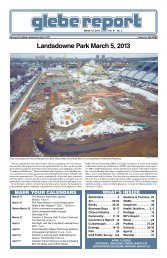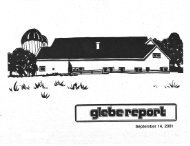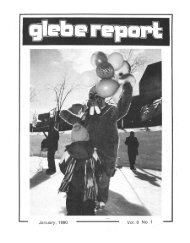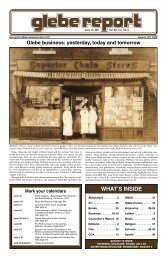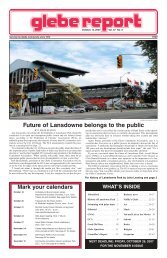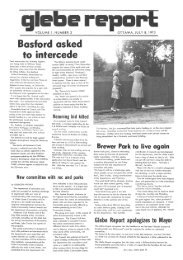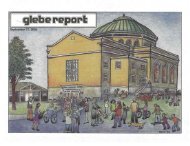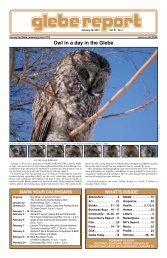April 16, 2010 - Glebe Report
April 16, 2010 - Glebe Report
April 16, 2010 - Glebe Report
You also want an ePaper? Increase the reach of your titles
YUMPU automatically turns print PDFs into web optimized ePapers that Google loves.
GLEBE HISTORY<br />
Heritage spaces, not endangered spaces<br />
BY Joan Bard Miller<br />
The current process to turn nearly 25 per cent of Lansdowne Park into commercial<br />
development is inappropriate and inconsistent with its nearly 150-year<br />
history as a public space. The park is historically associated with sports, recreation<br />
and exhibitions, but may soon be associated with large-scale retail. For<br />
these reasons, the <strong>Glebe</strong> Community Association has nominated Lansdowne<br />
Park for Heritage Canada Foundation’s Top Ten Most Endangered Places List.<br />
The annual list identifies significant heritage sites at risk due to neglect, lack of<br />
funding, weak legislation or inappropriate development. Lansdowne Park has<br />
suffered from all of the above threats for many years.<br />
The grounds and the buildings, including the municipally designated Horticulture<br />
Building, have been underutilized while maintenance to the sports facilities<br />
has been underfunded. The city threatens its own heritage designation<br />
by entertaining options to relocate a masonry building that is approximately<br />
200 feet in length. Rather than finding a lucrative, adaptive reuse, the city is<br />
considering a plan that is logistically and financially unfeasible.<br />
Initial threats to the fabric of the Aberdeen Pavilion National Historic Site<br />
have been mitigated, but plans for the building remain unclear. City-wide concerns<br />
about the proposed development have led to additional reports and studies,<br />
but they have not led to a fundamental change in what is being promised<br />
for the site – large-scale retail. Lansdowne Park’s history and proximity to the<br />
Rideau Canal World Heritage Site in the heart of the Nation’s capital should be<br />
worthy of continued use as a public space of world-class caliber, not endangerment.<br />
Heritage Canada Foundation will release its list in May <strong>2010</strong>.<br />
Aerial photo of Lansdowne Park circa 1930<br />
<strong>Glebe</strong> <strong>Report</strong> <strong>April</strong> <strong>16</strong>, <strong>2010</strong> 15<br />
Photo courtesy of NCC<br />
Heritage update<br />
Clemow Estate East Heritage Conservation District Study<br />
By Joan Bard Miller<br />
In other heritage news, on Wednesday, March 24, city heritage planners Sally<br />
Coutts and Lesley Collins hosted a meeting for residents living in the proposed<br />
Heritage Conservation District. The study area, which encompasses the houses<br />
delineating Patterson Creek and the eastern portion of Central Park, was first<br />
studied and proposed as a heritage district in 2004 with a public meeting held<br />
in December 2004. The draft of the study and plan was completed this winter.<br />
Approximately 40 local residents attended the March meeting and many of<br />
them asked questions of the presenters. The presentation included a history of<br />
the area’s development, an explanation of the evaluation process, objectives<br />
and guidelines for the district. A second public meeting will be held in June<br />
and city staff hope the proposed designation will go before the Ottawa Built<br />
Heritage Advisory Committee (OBHAC), Planning and Environment Committee<br />
(PEC) and city council this fall.<br />
The draft Clemow Estate East Heritage Conservation District Study is available<br />
online at www.glebeca.ca/committees/heritage.<br />
Joan Bard Miller is chair of the GCA Heritage Committee.




